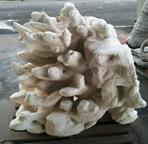
3D Printing Links
J. Carlton Collins, CPA
3D Printing a Wrench - https://youtu.be/jQ-aWFYT_SU?t=112
Amazing Items made with 3D Printers - https://www.youtube.com/watch?v=dcX41EQ1JTo
3D Printing 10 Houses in 24 days - https://youtu.be/WzmCnzA7hnE
Faster 3D Printing using fluid self-curing materials - https://www.youtube.com/watch?v=ihR9SX7dgRo 3D printing is actually 2D printing, over and over (or is it?)
3D Printing an Ear - https://youtu.be/G0EJmBoLq-g?t=48 (:47 to 1:47)
Ten different types of 3D Printers - https://youtu.be/hNyFL4a4DKM?t=10
Printing a Pizza - https://www.youtube.com/watch?v=MGxr3boyIus
Mini-Me 3D Statue at Walmart (the Duplicator from DOO3D) - https://www.youtube.com/watch?v=Wnjm6LcMcQA
Staples to bring 3D printing to the masses - http://blogs.marketwatch.com/behindthestorefront/2014/04/11/staples-aims-to-bring-3-d-printing-to-the-masses/
History:
1981 - Hideo Kodama of Nagoya Municipal
Industrial Research Institute invented three-dimensional fabricating methods
using plastic model with photo-hardening polymer, where the UV exposure area is
controlled by a masking pattern.
1984 - Chuck Hull of 3D Systems Corporation, developed a prototype system based on this process known as stereolithography, in which layers are added by curing photopolymers with ultraviolet light lasers one layer at a time. His biggest contribution was contribution is the design of STL (STereoLithography) file format which is widely accepted by many of today's 3D printers.
1990's - New material techniques were developed at Stanford and Carnegie Mellon University, including microcasting and sprayed materials. Sacrificial and support materials had also become more common, enabling new object geometries.
2000's - Additive processes became more common, and material removal disappeared from the 3D printing process. During this decade, 3D printing was based primarily on polymer technologies.
2010's - 3D printing evolved to inlcude sequential-layer material addition/joining throughout a 3D work envelope under automated control, and metals widely began to be used to produce finished products.
Bioprinting - 3D bioprinting emerged as the process of generating 3D structures and geometries utilizing cells and an encapsulation material. The medical applications of 3D bioprinting are numerous, and are thus the subject of intensive research at academic institutions such as Cornell University and companies such as Organovo. One major application area of bioprinting is in the tissue engineering field of regenerative medicine.
Nano Scale 3D Printing - 3D printing techniques can be employed to construct nanoscale-size objects. Such printed objects are typically grown on a solid substrate, e.g. silicon wafer, to which they adhere after printing as they're too small and fragile to be manipulated post-construction.
Impact on Business
Apparel - 3D printing has spread
into the world of clothing with fashion designers experimenting with 3D-printed
bikinis, shoes, and dresses. In commercial production
Nike is using 3D printing to
prototype and manufacture the 2012 Vapor
Laser Talon football shoe for players of American football, and
New Balance is 3D manufacturing
custom-fit shoes for athletes.

3D printing has come to the point
where companies are printing consumer
grade eyewear with on demand custom fit and styling (although they cannot
print the lenses). On demand customization of glasses is possible with rapid
prototyping.
Automobiles - In early 2014, the
Swedish supercar manufacturer,
Koenigsegg, announced the One:1,
a supercar that utilizes many components that were 3D printed. In the limited
run of vehicles Koenigsegg produces, the One:1 has side-mirror internals, air
ducts, titanium exhaust components, and even complete turbocharger assembles
that have been 3D printed as part of the manufacturing process.

An American company,
Local Motors is working with Oak
Ridge National Laboratory and Cincinnati Incorporated to develop large-scale
additive manufacturing processes suitable for
printing an entire car body. The
company revealed plans to print the vehicle live in front of an audience in
September 2014 at the International Manufacturing Technology Show. "Produced
from a new fiber-reinforced thermoplastic strong enough for use in an automotive
application, the chassis and body without drivetrain, wheels and brakes weighs a
scant 450 pounds and the completed car is comprised of just 40 components, a
number that gets smaller with every revision."

Urbee is the name of the first car
in the world car mounted using the technology 3D printing (his bodywork and his
car windows were "printed"). Created in 2010 through the partnership between the
US engineering group Kor Ecologic
and the company Stratasys
(manufacturer of printers Stratasys 3D), it is a hybrid vehicle with futuristic
look.

Aircraft - In May 2015 Airbus
announced that its new A350 XWB included over 1000 components manufactured by 3D
printing.

Construction - Until recent years
architects are often forced to show their clients drawings of their projects and
build models by hands. Using 3D printing, architects can now produce scale
models 50 to 80 percent faster, and up to 60 percent lighter. These improvements
on accuracy, speed and quality have opened new doors for it to move beyond the
use of 3-D printing in the modeling process and actually move it to
manufacturing strategy. For example, Dr. Behrokh Khoshnevis’ research at the
University of Southern California which resulted in a 3D printer that
can build a house in 24 hours
.The process is called Contour Crafting. Bushey also discussed Khoshnevis's
robot which comes equipped with a nozzle that spews out concrete and can build a
home based on a set computer pattern. Using this process, a single house or a
colony of houses, each with possibly a different design, may be automatically
constructed in a single run, embedded in each house all the conduits for
electrical, plumbing and air-conditioning.
Electric motors and generators -
Under a contract from the US Dept. of
Energy’s Arpa-E (Advanced Research Project Agency-Energy) program, a team
from the United Technologies Research Center as of 2014 was working toward
producing a 30 kW induction motor using
just additive manufacturing methods, trying to define an additively
manufactured induction motor capable of delivering 50 kW peak and 30 kW
continuous power over a speed range of zero to 12,000 rpm, using motor
technology that does not involve rare-earth magnets.
Firearms: 3D Printed Firearms - In
2012, the US-based group Defense
Distributed disclosed 3D printing plans for a
working plastic gun that could be
downloaded and reproduced by anybody with a 3D printer." Defense Distributed has
also designed a 3D printable AR-15
type rifle lower receiver (capable of lasting more than 650 rounds) and a 30
round M16 magazine. The AR-15 has multiple receivers (both an upper and lower
receiver), but the legally controlled part is the one that is serialized (the
lower, in the AR-15's case). Soon after Defense Distributed succeeded in
designing the first working blueprint to produce a plastic gun with a 3D printer
in May 2013, the United States Department of State demanded that they remove the
instructions from their website. After Defense Distributed released their plans,
questions were raised regarding the effects that 3D printing and widespread
consumer-level CNC machining may have on gun control effectiveness. In 2014,
Japan’s Yoshitomo Imura posted
videos and blueprints of the gun online and was
sentenced to jail for two years.
Police found at least two guns in his household that were capable of firing
bullets.



Medical - 3D printing has been used
to print patient specific implant and device for medical use. Successful
operations include a titanium pelvis
implanted into a British patient,
titanium lower jaw transplanted to a Belgian patient, and a
plastic tracheal splint for an American
infant. The hearing aid and dental industries are expected to be the biggest
area of future development using the custom 3D printing technology. In March
2014, surgeons in Swansea used 3D printed parts to
rebuild the face of a motorcyclist
who had been seriously injured in a road accident. Research is also being
conducted on methods to bio-print replacements for lost tissue due to arthritis
and cancer.



Medical Devices - In October 24,
2014, a five-year-old girl born without fully formed fingers on her left hand
became the first child in the UK to have a
prosthetic hand made with 3D
printing technology. Her hand was designed by US-based E-nable, an open source
design organization which uses a network of volunteers to design and make
prosthetics mainly for children. The prosthetic hand was based on a plaster cast
made by her parents. A boy named Alex was also born with a missing arm from just
above the elbow. The team was able to use 3D printing to upload an e-NABLE
Myoelectric arm that runs off of servos
and batteries that are actuated by the electromyography muscle. With the use
of 3D printers, E-NABLE has so far distributed more than
400 plastic hands to children.

Printed prosthetics have been
used in rehabilitation of crippled
animals. In 2013, a 3D printed foot
let a crippled duckling walk again. In 2014 a chihuahua born without front
legs was fitted with a harness and
wheels created with a 3D printer. 3D
printed hermit crab shells let hermit crabs inhabit a new style home. A
prosthetic beak was another tool developed by the use of 3D printing to help aid
a bald eagle named Beauty, whose beak
was severely mutilated from a shot in the face. Since 2014, commercially
available titanium knee implants made
with 3D printer for dogs have been used to restore the animal mobility.
Over 10,000 dogs in Europe and U.S.
have been treated after only one year.



In February 2015, FDA approved
the marketing of a surgical bolt
which facilitates less-invasive foot surgery and eliminates the need to drill
through bone. The 3-D printed titanium device, 'FastForward Bone Tether Plate'
is approved to use in correction surgery
to treat bunion.

Bio-printing - As of 2012, 3D
bio-printing technology has been studied by biotechnology firms and academia for
possible use in tissue engineering applications in which organs and body parts
are built using inkjet techniques. In this process,
layers of living cells are deposited
onto a gel medium or sugar matrix and slowly built up to form three-dimensional
structures including vascular systems.
In 2013, Chinese scientists began
printing ears, livers and kidneys, with
living tissue. Researchers in China have been able to successfully print
human organs using specialized 3D bio printers that use living cells instead of
plastic. Researchers at Hangzhou Dianzi University designed the "3D bio printer"
dubbed the "Regenovo". Xu Mingen, Regenovo's developer, said that it takes the
printer under an hour to produce either a mini liver sample or a four to five
inch ear cartilage sample. Xu also predicted that
fully functional printed organs may be
possible within the next ten to twenty years. In the same year, researchers
at the University of Hasselt, in Belgium had successfully printed a
new jawbone for an 83-year-old Belgian
woman.



In January 2015, it was reported
that doctors at London’s St Thomas' Hospital had used images obtained from a
Magnetic Resonance Imaging (MRI) scan to create a
3D printing replica of the heart of a
two-year-old girl with a ‘very complex’ hole in it. They were then able to
tailor a Gore-Tex patch to effect a cure. The lead surgeon of the operating
team, Professor David Anderson, told The Sunday Times: “The 3D printing meant we
could create a model of her heart and then see the inside of it with a replica
of the hole as it looked when the heart was pumping. We could go into the
operation with a much better idea of what we would find”. The 3D printing
technique used by the hospital was pioneered by Dr Gerald Greil.
Computers and Robots - 3D printing
can be used to make laptops and other
computers, including cases, as Novena and VIA OpenBook standard laptop
cases. I.e. a Novena
motherboard
can be bought and be used in a printed VIA OpenBook case.
Open-source robots are built
using 3D printers. Double Robotics
grant access to their technology (an open SDK). On the other hand,
3&DBot is an Arduino
3D printed-robot with wheels and
ODOI is a 3D printed humanoid robot.


Space - In September 2014,
SpaceX delivered the first
zero-gravity 3-D printer to the International Space Station (ISS). On December
19, 2014, NASA emailed CAD drawings for a
socket wrench to astronauts aboard
the ISS, who then printed the tool using its 3-D printer. Applications for space
offer the ability to print broken parts or tools on-site, as opposed to using
rockets to bring along pre-manufactured items for space missions to human
colonies on the moon, Mars, or elsewhere. The European Space Agency plans to
deliver its new Portable On-Board 3D Printer (POP3D for short) to the
International Space Station by June 2015, making it the second 3D printer in
space.
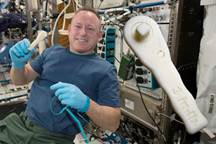
Art (3D Printed
Ceramic Pot) - In 2005, academic journals had begun to report on the
possible artistic applications of 3D printing technology. By 2007 the mass media
followed with an article in the Wall Street Journal and Time Magazine, listing a
3D printed design among their 100 most influential designs of the year. During
the 2011 London Design Festival, an installation, curated by Murray Moss and
focused on 3D Printing, was held in the Victoria and Albert Museum (the V&A).

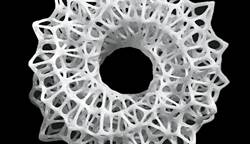

Some of the recent developments in 3D printing were
revealed at the 3DPrintshow in London, which took place in November 2013 and
2014. The art section had in exposition artworks made with 3D printed plastic
and metal. Several artists such as Joshua Harker, Davide Prete, Sophie Kahn,
Helena Lukasova, Foteini Setaki showed how 3D printing can modify aesthetic and
art processes. One part of the show focused on ways in which 3D printing can
advance the medical field. The underlying theme of these advances was that these
printers can be used to create parts that are printed with specifications to
meet each individual. This makes the process safer and more efficient. One of
these advances is the use of 3D printers to produce casts that are created to
mimic the bones that they are supporting. These custom-fitted casts are open,
which allow the wearer to scratch any itches and also wash the damaged area.
Being open also allows for open ventilation. One of the best features is that
they can be recycled to create more casts.
3D Printed
Chocolate - 3D printing is becoming more popular in the customizable gifts
industry, with products such as personalized mobile phone cases and dolls, as
well as 3D printed chocolate.


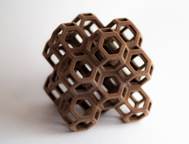
The use of 3D scanning technologies allows the
replication of real objects without the use of moulding techniques that in many
cases can be more expensive, more difficult, or too invasive to be performed,
particularly for precious or delicate cultural heritage artefacts[160] where
direct contact with the moulding substances could harm the original object's
surface.
Communication - Employing additive
layer technology offered by 3D printing, Terahertz devices which act as
waveguides, couplers and bends have been created. The complex shape of these
devices could not be achieved using conventional fabrication techniques.
Commercially available professional grade printer EDEN 260V was used to create
structures with minimum feature size of 100 µm. The printed structures were
later DC sputter coated with gold (or any other metal) to create a Terahertz
Plasmonic Device.[165]
Domestic Use (Using a MakerBot Replicator 2) - As of
2012, domestic 3D printing was mainly practiced by hobbyists and enthusiasts,
and was little used for practical household applications. A working clock was
made and gears were printed for home woodworking machines among other purposes.
3D printing was also used for ornamental objects. Web sites associated with home
3D printing tended to include backscratchers, coat hooks, doorknobs etc.
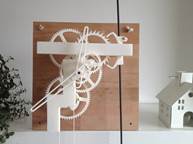


The open source Fab@Home project has developed printers
for general use. They have been used in research environments to produce
chemical compounds with 3D printing technology, including new ones, initially
without immediate application as proof of principle. The printer can print with
anything that can be dispensed from a syringe as liquid or paste. The developers
of the chemical application envisage both industrial and domestic use for this
technology, including enabling users in remote locations to be able to produce
their own medicine or household chemicals.

3D printing is now working its way into households and
more and more children are being introduced to the concept of 3D printing at
earlier ages. The prospects of 3D printing are growing and as more people have
access to this new innovation, new uses in households will emerge.
3D Printed Camera - The OpenReflex
SLR film camera was developed for 3D printing as an open-source student project.
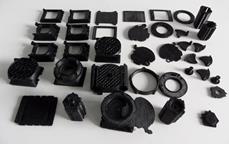
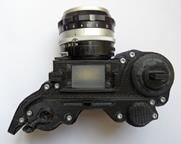
Education and
Research - 3D printing, and open source RepRap 3D printers in particular,
are the latest technology making inroads into the classroom. 3D printing allows
students to create prototypes of items without the use of expensive tooling
required in subtractive methods. Students design and produce actual models they
can hold. The classroom environment allows students to learn and employ new
applications for 3D printing. RepRaps, for example, have already been used for
an educational mobile robotics platform.
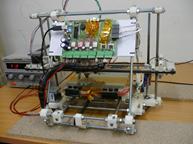
Some authors have claimed that RepRap 3D printers offer
an unprecedented "revolution" in STEM education. The evidence for such claims
comes from both the low cost ability for rapid prototyping in the classroom by
students, but also the fabrication of low-cost high-quality scientific equipment
from open hardware designs forming open-source labs. Engineering and design
principles are explored as well as architectural planning. Students recreate
duplicates of museum items such as fossils and historical artifacts for study in
the classroom without possibly damaging sensitive collections. Other students
interested in graphic designing can construct models with complex working parts.
3D printing gives students a new perspective with topographic maps. Science
students can study cross-sections of internal organs of the human body and other
biological specimens. And chemistry students can explore 3D models of molecules
and the relationship within chemical compounds.
Environmental Use - In Bahrain,
large-scale 3D printing using a sandstone-like material has been used to create
unique coral-shaped structures, which encourage coral polyps to colonize and
regenerate damaged reefs. These structures have a much more natural shape than
other structures used to create artificial reefs, and, unlike concrete, are
neither acid nor alkaline with neutral pH.
